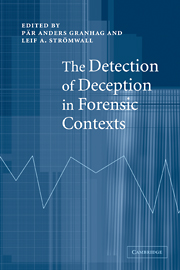Book contents
- Frontmatter
- Contents
- List of figures
- List of tables
- List of contributors
- Part 1 Introduction
- Part 2 Lie-detection techniques
- Part 3 Special issues facing a lie-catcher
- Part 4 Enhancing lie-detection accuracy
- 10 Practitioners' beliefs about deception
- 11 Training to detect deception from behavioural cues: attempts and problems
- 12 The wizards of deception detection
- 13 Guidelines to catch a liar
- Part 5 Conclusions
- Index
- References
11 - Training to detect deception from behavioural cues: attempts and problems
Published online by Cambridge University Press: 22 September 2009
- Frontmatter
- Contents
- List of figures
- List of tables
- List of contributors
- Part 1 Introduction
- Part 2 Lie-detection techniques
- Part 3 Special issues facing a lie-catcher
- Part 4 Enhancing lie-detection accuracy
- 10 Practitioners' beliefs about deception
- 11 Training to detect deception from behavioural cues: attempts and problems
- 12 The wizards of deception detection
- 13 Guidelines to catch a liar
- Part 5 Conclusions
- Index
- References
Summary
Fifteen years ago at the beginning of a book chapter on training to detect deception (Bull, 1989) I noted that:
An advertisement urging people to join a British police force recently appeared in a Sunday newspaper. Part of it stated that, ‘Most people speak the truth most of the time. When they lie they experience stress and it usually shows’. Accompanying the words in the advertisement were a number of photographs of people. One of these showed a man touching the side of his nose with the index finger of his left hand. The caption for this stated that, ‘The man with his finger to his nose is showing one of the signals associated with lying’. The advertisement continued by saying that, ‘After training, you'll register the particular things a person does when conversing normally. When a change of topic brings about significant changes in their actions you'll notice that too’.
Another similar advertisement stated, ‘If you're interviewing a suspect, how do you know if he's telling the truth? You'll be taught the rudiments of body language, gesticulation and body movements that indicate stress and nervousness’.
In closing that chapter I made the point that:
Until a number of publications in refereed journals appear demonstrating that training enhances the detection of deception, it seems that some police recruitment advertisements and police training books are deceiving their readers.
This chapter will focus on attempts to train groups of people to detect deception from non-verbal behaviour.
Information
- Type
- Chapter
- Information
- The Detection of Deception in Forensic Contexts , pp. 251 - 268Publisher: Cambridge University PressPrint publication year: 2004
References
Accessibility standard: Unknown
Why this information is here
This section outlines the accessibility features of this content - including support for screen readers, full keyboard navigation and high-contrast display options. This may not be relevant for you.Accessibility Information
- 12
- Cited by
